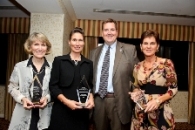Transportation Security Administration – Aviation Security Advisory Committee
ASAC was founded with legislation by the Pan Am 103 family members in 1989. NADA/F became a member organization of ASAC in 2000, and we continue to serve, as well as PA103 family members.
ASAC is a standing committee composed of about 30 member organizations from the Federal Government, aviation industry, and private sector. Membership is approved by TSA.
ASAC’s mission is to examine areas of civil aviation security as tasked by TSA with the aim of developing recommendations for the improvement of aviation security methods, equipment and procedures.
On November 19, 2001, ASAC was transferred from the FAA to the new agency TSA (Transportation Security Administration) via ATSA, the Aviation and Transportation Security Act. TSA assumed management of ASAC August 2002. Glenn Johnson, from PA103, was active with the Cargo Security Working Group; and PA103 and NADA/F have been member organizations.
Under the FAA, ASAC functioned well for over ten years, met more frequently, and was more productive. Under TSA, ASAC met less frequently from 2004-2006, when TSA inactivated the Committee.
NADA/F participated with BSIS-WG, (Baggage Screening Investment Study Working Group) which recommended improved airport screening security technology. BSIS-WG met from 2005-2006 and released their extensive report and recommendations on August 9, 2006.
Historically, with ARAC and ASAC, the Working Group members were appointed from ASAC Member Organizations, however, TSA appointed the BSIS working group members from the security industries. As a member organization we were briefed and support the report, but results from that study have not been reported to ASAC members.
ASAC moves slowly, however, it does give NADA/F an important place at the table to represent the traveling public, and participate in security recommendations and rulemaking. It is also an opportunity to work with people from the industry.
TSA makes the decisions about which airport security technology to purchase. After 9/11 TSA spent quite a bit of money, but there was lack of a Master Plan, and some technology has not worked well. Some technology took too much time, and they learned the size of an airport is also a consideration for what might work best. Airport security has improved, but we need much more.
ASAC was re-organized under TSA in 2008 with a two to three year charter and approximately 30 member organizations (including government agencies). NADA/F was re‑appointed a member organization December 2008 and we are honored to serve.
- NADA/F has always supported professional federal airport security screeners, who are U.S. citizens, and able to meet a proficiency level. NADA/F voted unanimously at our Annual Meeting in 2004 to support federal screeners, with rights to organize as federal employees. We are opposed to returning to the pre‑9/11 outsourced airport security.
- NADA/F supports the need for bomb-proof baggage containers (technology was completed 10-15 years ago), increased screening of checked baggage and air cargo, and security screening of private flights. It was announced late 2008 that TSA will begin security screening of private aircraft.
- After Pan Am 103, over 20 years ago, and 9/11, seven years ago, aviation security should have been a much higher priority. NADA/F stays committed for the long term to have state-of-the-art airport security at all levels.

